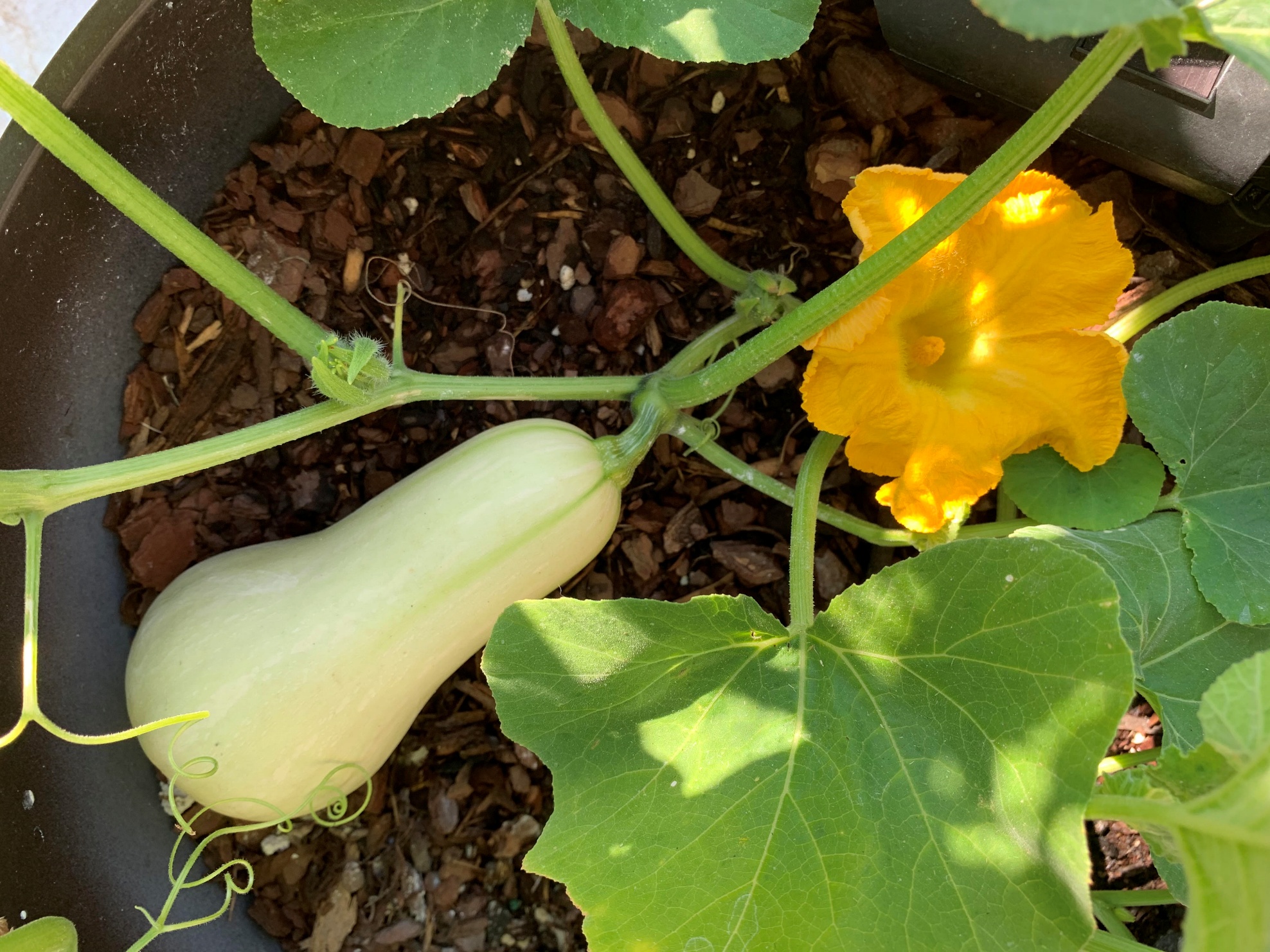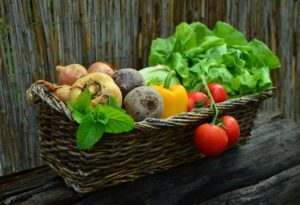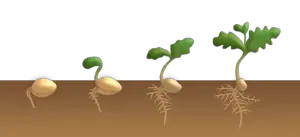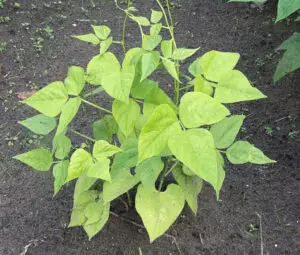Starting a garden can seem a bit intimidating. You may think that only those with a green thumb can grow a successful garden. But the truth is, having a productive garden has nothing to do with the color of your thumb. Rather, it has everything to do with having a desire to grow your own flowers, herbs, or vegetables, and having access to the right information. In this article, we’ll cover all the basics on how you (yes, you!) can start your own container garden.
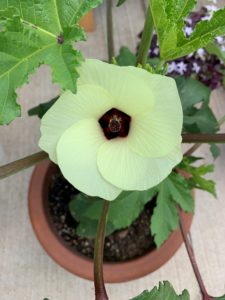
Plant According to Your Hardiness Zone
The first step in starting a garden is to find out what zone you live in as this will determine what you can plant and when you can plant it. You might be asking, what is a zone? The U.S. Department of Agriculture developed a map based on the country’s average minimum temperatures and divided it into thirteen hardiness zones or areas, which are then further divided into subzones. There is a 10ºF difference between neighboring zones and a 5°F difference between subzones. While the zone map isn’t an absolute, it is a good guide for knowing which plants work best in each zone. To find out which zone you’re in, follow this link and type in your zip code. Your zone will display beneath where you typed in your zip code. (This link is also listed on my Resource page.)
Other countries have adapted the hardiness zone method for their regions. Note, however, that a zone in one country may not be the perfect equivalent of the same zone in another country. For example, if you live in Canada, the Natural Resources Canada (NRC) calculates the zones differently. You can find their hardiness zone map here.
Know Your Frost Dates
In addition to knowing what zone you live in, you’ll need to know your area’s first and last frost dates, which occur in the late fall and early spring, respectively. Frost dates are determined by the National Centers for Environmental Information (NCEI) and are based on historical weather data. They are not meant to be predictive, per se, but should serve as an estimate to help you plan.
It’s important to know your frost date so that you can calculate if there will be enough time for a plant to mature before the first frost. Otherwise, the frost may kill the plant before it can be harvested. Conversely, it’s important to know the last frost date so that you don’t plant seeds or place plant starts in the garden before the season’s last cold snap.
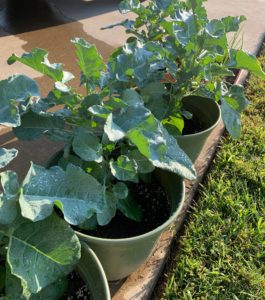
To find the first and last frost dates for your area click here and then click on the zone that you live in. Your area’s frost dates will be listed at the top of the page. This site will also give you a partial list of vegetables, herbs, and flowering plants that are suited for your zone. Click on the name of the plant to find out if there is enough time to plant it with regard to the frost dates. Know, however, that this site offers broad guidelines. The specific plant variety and how many days it takes to mature will provide you with a more concrete answer. You’ll be able to find that information on the seed packet. It’s usually listed as “days to maturity.” Many seed companies also list on the packets the specific months that are ideal for planting the seeds in different regions.
This article contains affiliate links. If you make a purchase using one of these links, I will receive a very small commission at no additional cost to you, and it will help me maintain this website. Rest assured, I only recommend products I actually like!
Plant According to the Season
It almost goes without saying, but if you plant a flower or a vegetable out of season, even if it is a variety that is suited for your zone, it won’t produce. Thus, it’s important to choose a plant that is conducive to the season you’re in. Granted, there are ways to use greenhouses, cold frames, and indoor grow lights to extend seasons or get a jump start on the next season, but by and large, watermelons simply won’t grow in the dead of winter, and pansies won’t thrive in the heat of summer.[1]
If you’re a beginner gardener and zones, frost dates, and days to maturity seems a bit overwhelming, you can simplify things by following this general rule: if the big box stores or your local nursery are selling a plant, chances are the window of opportunity to plant that variety is still open. You can always ask the employees in the garden department for help if you have any questions. But at some point, you’ll want to become more familiar with planting according to zones and frost dates.
Plan Out the Space for Your Containers
Next, you’ll need to plan out the growing space to determine how many plants you can grow and the number of containers you’ll need. Be sure to select a space that receives at least six hours or more of full sun. Plants may grow in less sun, but they won’t produce because it takes more energy from the sun to develop vegetables. The first time I planted zucchini, the plant was beautiful, but it never developed fruit because, as I found out later, the spot I planted it in didn’t receive enough sunlight. So, take a few days and watch the pattern of the sun to see which areas have the best sun exposure. Know that when the seasons change, the area may receive more or less sun exposure because the angle of the sun changes with the seasons. For example, my back porch receives six hours of full sun in the summer, but less than that the remainder of the year.
If you have very limited space like I do, you may need to get creative. One of the advantages of growing in containers is that they can be placed anywhere and easily relocated if necessary! You can set containers or raised planter boxes on your back porch or lawn, but you can also place them on your front porch, in your front yard, and even in your driveway! (If you want to build your own planter box, here is a simple step by step tutorial!) Remember, window boxes are another great option! Of course, balconies, railings, and even wide stoops are prime real estate when it comes to container gardening. Regardless of which areas you choose, make sure they get adequate sunlight.
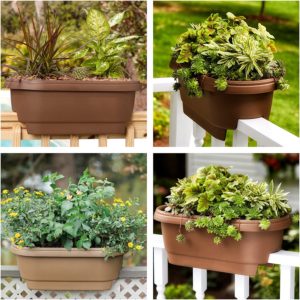
Choose What You’re Going to Plant
Now that you’ve got your space picked out, it’s time to choose which plants you are going to grow. If you are going to start a vegetable garden, as opposed to a flower garden, I strongly suggest that you limit your selection to three or four kinds of vegetables. Planting seeds and harvesting crops are the fun and rewarding stages of gardening, but it’s the growing stages where challenges will arise. Every garden, large or small, has to contend with pests and diseases. The more crops you grow, the greater the potential for you to become overwhelmed. Once you get some experience under your belt, you’ll be able to comfortably and confidently take on more.
Gather the Items You’ll Need
Once you’ve decided which vegetables to grow, you’ll need to gather the following items:
Quality potting mix. While you can make your own potting mix, you may want to simplify things by purchasing a good organic potting mix from a box store or your local plant nursery. You can learn more about how to choose the right soil here.
Seeds or plant starts. Quality, organic, non-GMO seeds are available from reputable companies online who offer an abundant selection to choose from. But sometimes, too many choices can overwhelm a new gardener. Instead, you might want to opt for purchasing organic, non-GMO seeds from reputable companies at big box stores, your local plant nursery, or farm and feed stores. If it’s early in the season, they should have plenty to choose from or you can purchase individual or assortment packs online.
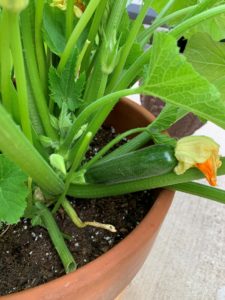
An alternative to starting your garden from seeds is to purchase plant starts, that is, plants that have been started in greenhouses, often by seed companies. These plants are still young but established and ready to be transplanted into your garden. By doing this you’ll save time and increase the likelihood of success since you’ll be starting with healthy plants and bypassing the germination and seedling stages. You can usually find plant starts at the same places where you purchase seeds.
Choose plants that look healthy and have plenty of new growth. Avoid plants that have yellowing leaves or show other signs of possible stress, disease, or insect damage.
Containers. When you select a container, keep in mind that it needs to accommodate the plant at maturity. It may look too big for the seedling, but that little seedling is going to grow, and it will need room to do so. Depending on the size of the plant at maturity, you may be able to place more than one plant per container. Some seed companies, like Burpee, provide that information on the back of the packet. For example, radishes are relatively small at maturity, so you can plant twelve Cherry Belle radish seeds in one 12″ (diameter) pot. Broccoli, on the other hand, is a larger plant, and it needs its own 12″ pot. According to the back of the seed packet, bib lettuce can be grown four plants to a 12″ container, while three German chamomile plants can be grown in a 12″ pot.
Make sure each container has drainage holes. Refrain from purchasing a planter that catches your eye because it looks pretty but it doesn’t have proper drainage holes. When you go to water the plant, the soil at the top will feel dry, while the soil at the bottom of the container will still be wet. This type of situation promotes root rot.
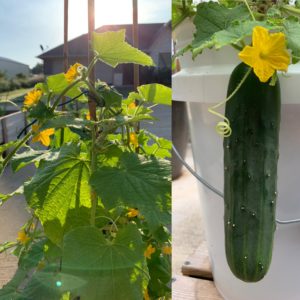
Today there are so many options to choose from when it comes to container selection. You can choose traditional containers from garden centers, but you can also select less conventional ones like food grade buckets that can be purchased online or at big box stores. Just know that you will need to drill holes for drainage. I’ve grown many different types of vegetables in these with very good success. Another option that has increased in popularity are grow bags, which are pots made of durable, lightweight, breathable fabric that is environmentally friendly. Two pros of using this type of container is that they keep the plant from becoming root bound and the containers store flat when not in use. These can also be purchased online or at big box stores and local plant nurseries.
I would stay away from using things like old tires, cinder blocks, treated lumber, or similar items as containers as they contain harmful chemicals that can leach into the soil. (You can learn more about how to choose the right containers for growing vegetables in this helpful article.)
Pest and Disease Control. Bugs and diseases are inevitable in the garden, so I include directions in each of my how to grow articles on how you can make your own organic solutions to treat your plants. One of the benefits of making your own sprays is that you’ll know they are free of chemicals and additives that are found in most of the commercial sprays, and therefore, safe to use. What’s more, it’s much more cost-effective to make your own.
One of the primary ingredients you’ll need to purchase for your DIY sprays is cold-pressed neem oil with the naturally occurring ingredient Azadirachtin. Neem oil is derived from the seeds of the neem tree, an evergreen that is indigenous to India. It is the go-to ingredient for organic pest control in the garden. You’ll also need to purchase a small bottle of Castile soap or other non-detergent soap that is chemical-free. The neem oil and soap used separately or in combination can be used to combat just about every pest and disease that may afflict your garden.
You’ll need to get a couple of inexpensive BPA-free plastic spray bottles to mix your solutions in. But wait until the first sign of trouble before mixing the solutions because some recipes, once mixed, don’t have a particularly long shelf life.
Fertilizer. Fertilizer plays an important role in every garden, but even more so in a container garden because water passing through the soil will wash away vital nutrients faster than it would in an in-ground garden. Choose an organic fertilizer that contains balanced levels of nitrogen (N), phosphorus, (P) and potassium (K), and use according to package directions. You can purchase a dry fertilizer like Dr. Earth’s that not only contains balanced levels of N, P, and K, but also probiotics, beneficial soil microbes, and mycorrhizae that build healthy soil which is vital to growing healthy plants. This type of fertilizer can also be used as an amendment to revitalize soil that has previously been used. In addition, there is a liquid version of Dr. Earth’s that you add to a watering can and apply once a week. Bone meal, blood meal, and fish emulsion are also good options but require a bit more instruction.
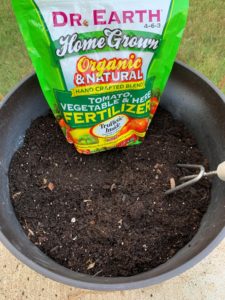
Compost tea and worm tea are also good fertilizer options, but beginner gardeners may want to get a season or two of gardening under their belts before starting another project like a compost pile.
Watering Method. You’ll need a source of water that’s accessible from your garden. A water hose with an adjustable spray nozzle is ideal. Or you may prefer using a watering can. I use both, depending on the application. You can choose which works best for you.
Garden Gloves are a practical way to protect your hands from getting dirty, but, speaking from experience, they also come in handy when you need to squash a bug and other, less than glamorous garden chores. It’s also helpful to have an inexpensive pair of disposable dish-washing gloves for when you apply your DIY garden sprays.
Acquire Helpful Resources
One of the most helpful items you’ll need for your container garden is good resources. Detailed reference books and websites can answer your questions quickly and effectively. (Hopefully, you’ll consider OkraInMyGarden.com as your go-to resource!) While there are a number of YouTube gardening channels that I enjoy watching, I’ve found that they aren’t always the quickest source of information since you may have to listen to a few fifteen to twenty-minute videos before you find your answer.
A Can-Do Attitude
Last, but certainly not least, a new gardener is going to need a can-do attitude. Know for certain that challenges will arise that may cause you frustration and dampen your enthusiasm. You don’t need to worry that you might fail. I can assure you that you will fail. But you won’t be the first person to accidentally kill a plant, nor the first to lose a plant even though you did everything by the book. Having a good attitude will help you through the ups and downs of gardening and enable you to persevere to the harvest. Someone once said, there are no garden failures, just opportunities to learn how to do it differently next time.
Growing and harvesting your own food is so very rewarding! Most will agree that fresh, organic, homegrown produce tastes better and is better for you than store-bought. So what are you waiting for? Start planting!
If you found this article helpful, please share it with someone you feel might be interested in starting their own garden.
[1] Watermelons are a warm-season crop and pansies do best in cooler weather.
